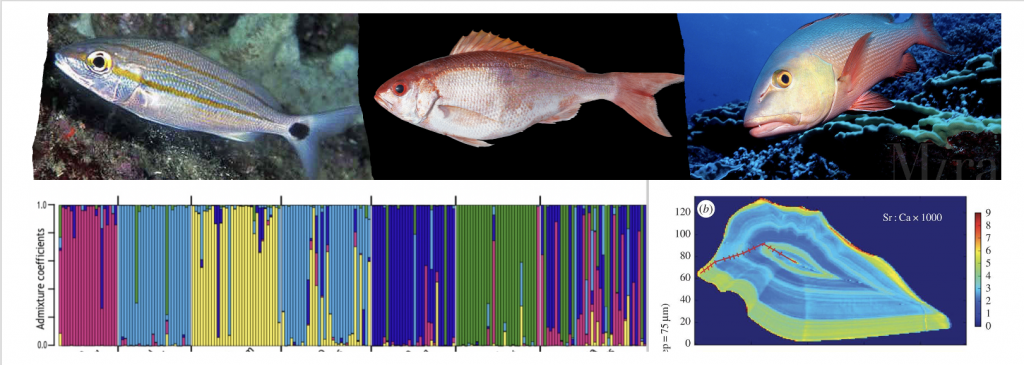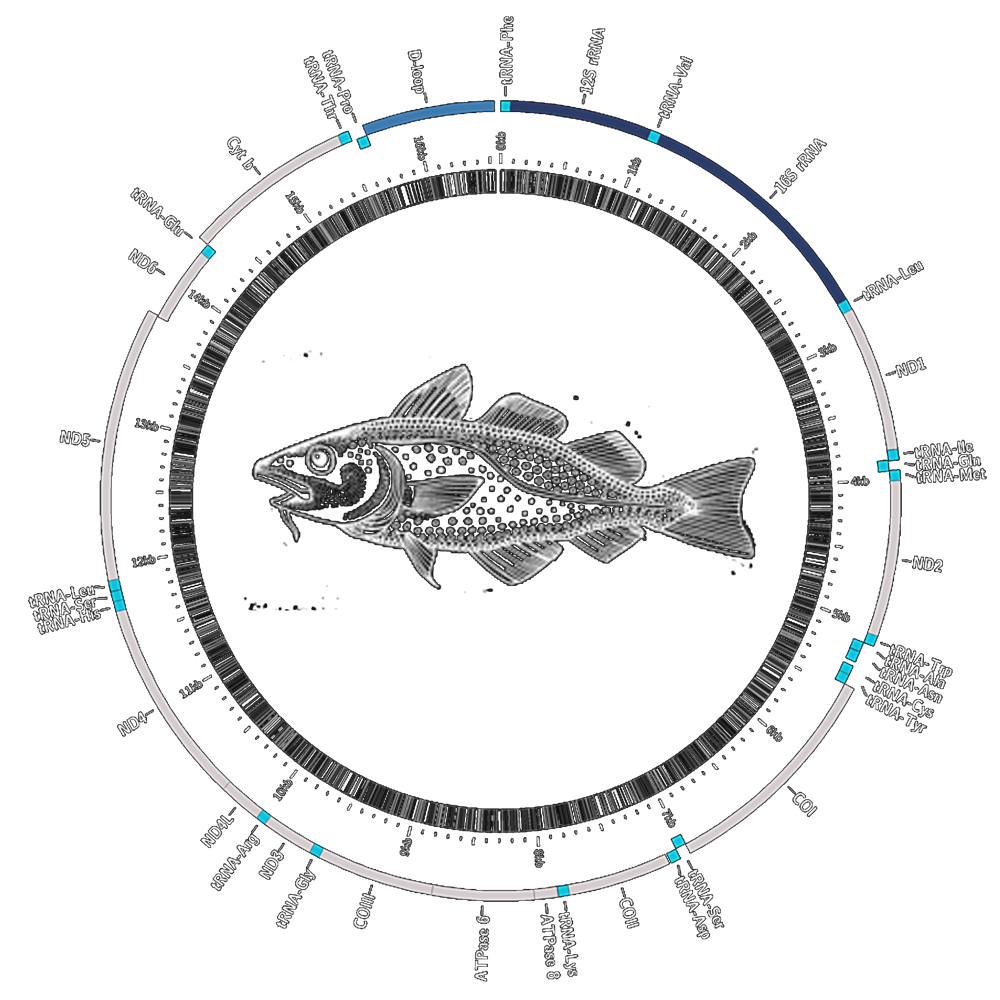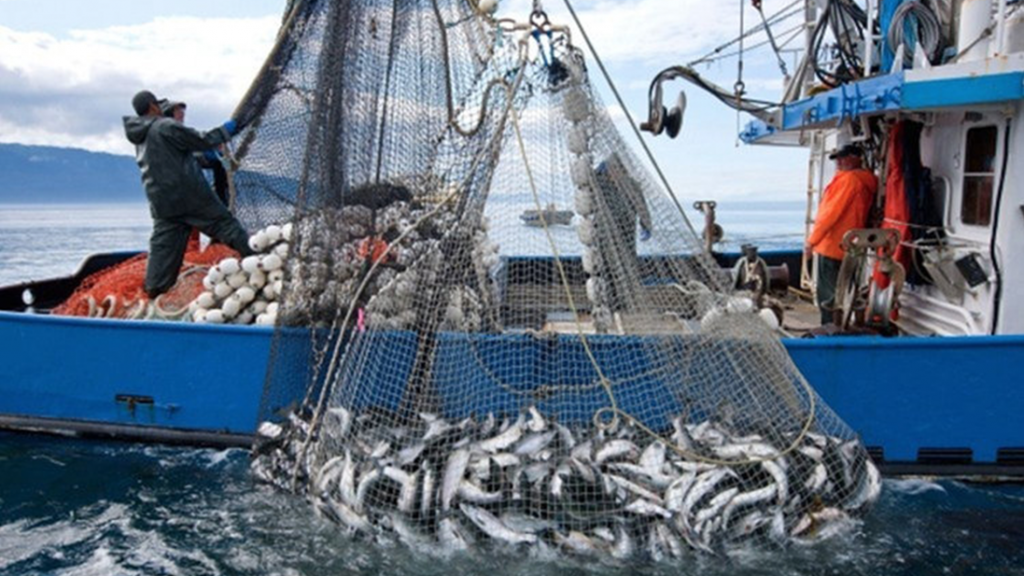Systematics
Phylogenetics
I investigate evolution at multiple spatial and temporal scales by integrating morphological, ecological, fossil, and genomic data to better understand how fishes have diversified and persisted in diverse habitats and developed a wide array of life history strategies.
I often focus my questions on gadiform fishes because of their economic importance (e.g., codfishes, hakes, codlings, rattails) and because they are found in a diversity of habitats ranging from the poles to the tropics and from shallow waters to the deep sea. They are an excellent model system for elucidating patterns in marine diversity, while providing critical information for fish conservation.

Integrate Taxonomy for Species Delimitation
As a tool for fisheries conservation
Hake species (Merluccius spp.) are one of many fish groups for which taxonomy has been poorly resolved via morphology or molecular-based methods used independently. I am currently using genome-wide single nucleotide polymorphism (SNPs) and morphology to delimit these species. These analyses will help to identify species boundaries by implementing non-coalescent and coalescent-based species delimitation methods and assess the extent of genetic isolation among putative species by estimating spatio-temporal gene flow.

Integrate Taxonomy for Species Delimitation
As a tool for fisheries conservation
Hake species (Merluccius spp.) are one of many fish groups for which taxonomy has been poorly resolved via morphology or molecular-based methods used independently. I am currently using genome-wide single nucleotide polymorphism (SNPs) and morphology to delimit these species. These analyses will help to identify species boundaries by implementing non-coalescent and coalescent-based species delimitation methods and assess the extent of genetic isolation among putative species by estimating spatio-temporal gene flow.
Comparative morphology
Using novel and traditional techniques
A goal of my research is to expand our understanding of how novel traits evolve and promote diversification. I use gadiforms to investigate when fish diversify and what traits led to their successful colonization in shallow waters to deep-sea environments. For instance, the caudal skeleton of Gadiformes is a complex structure that exhibits substantial diversity among major subgroups, ranging from tailless fishes (e.g., rattails) to those with externally symmetrical caudal fins (e.g., codfishes). I am using ontogenetic series, adult specimens, x-rays, clearing and staining, and CT-scans to better understand the evolution of this structure plays a key role in locomotion that is closely correlated with habitat and ecological niche.


Biogeography
and Timing
Of lineage diversification
I am using diverse research methods to study the historical and ecological factors that can explain the distribution of species across space patterns. Understanding geographic and ecological patterns of diversification allow the assessment of the transition(s) between freshwater and marine environments, the modes of colonization of deep-water habitats by fishes, which has long been debated and why do some places contain more species of than others among other relevant questions.
Seascape Ecology
habitat Connectivity
& population Genomics
To determine whether the Deepwater Horizon oil spill altered the trophic ecology of Red Snapper Lutjanus campechanus and Vermillion Snapper Rhomboplites aurorubens, two of the most economically important species in the Gulf of Mexico (GoM), I am using RADSeq approaches to reveal connectivity patterns, dispersal rates and directionality of gene flow in these species. I am also examining ecological connectivity over longer time scales by analyzing the chemical signatures of fish otoliths (elemental analysis and stable isotopes).
Using laser ablation-inductively coupled mass spectrometry and isotope-ratio mass spectrometry methods, I am examining a) changes in habitat use with age, including identifying nursery sources by comparing the chemistry of the core and the edge of the otoliths, b) fish movement from shallow to deeper waters (vertical connectivity) using ẟ18O analysis, and c) ontogenetic shifts in diet using δ13C and δ15N.
This research is part of a NOAA-funded interdisciplinary research project (“Connectivity of Coral Ecosystems in the Northwestern Gulf of Mexico”; Herrera, PI) focused on providing the ecosystem connectivity data needed to support boundary expansion of current marine protected areas in the GoM and the Caribbean. These efforts are critical to documenting species diversity and distribution in shallow (15-40m), upper mesophotic (40-85m), and lower mesophotic (85-150m) coral ecosystems and will directly inform future management and restoration activities.

Museum Genomics
Genome Skimming and DNA Barcodes
An accurate, comprehensive reference sequence library maximizes information gained from environmental DNA (eDNA) metabarcoding of marine fishes. Combining a taxonomy based on DNA with descriptive taxonomy will provide the data that is needed to monitor various ecosystem services (such as the natural history, connectivity, and function of species) and to help high-seas fish conservation.
Building the reference database for biodiversity studies of deep-sea fishes present in the US Exclusive Economic Zone (EEZ) is a project is a collaborative effort aligned with Smithsonian DNA Barcode Network (SIBN) and National Oceanic and Atmospheric Administration (NOAA) Ocean Exploration priorities focused on unexplored areas of the US EEZ below 200 meters.


Genomic Adaptation of the Arctic Codfishes
Accurate taxonomy is fundamental to determining the conservation status of fishes, properly managing their fisheries, and evaluating and prioritizing the need for conserving their habitats.
I am working on clarifying the taxonomy and phylogenic relationships of Gadidae using genomics. Additionally, I am studying the relationships between genotype frequencies and environmental characteristics of the sea, in combination with connectivity analyses to investigate the adaptive potential of Arctic codfishes.
Conservation



Our oceans are seen as a source of infinite resources and appear invulnerable to overexploitation due to their enormous size, depth and unexplored frontiers.
However, habitat loss, pollution, ocean acidification, global warming, and unsustainable fishing practices are directly impacting freshwater and marine ecosystems.
I am committed to support marine and freshwater inventory initiatives that help to describe fish diversity and foster new initiatives for conservation as a fish specialist involved in the Global Marine Species Assessment (GMSA) and the International Union for Conservation of Nature (IUCN).
